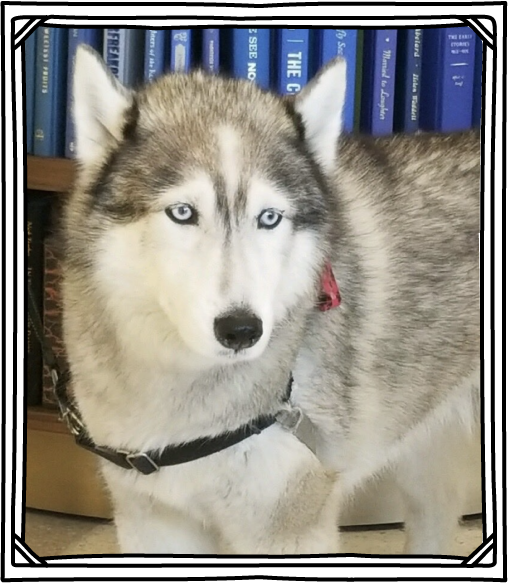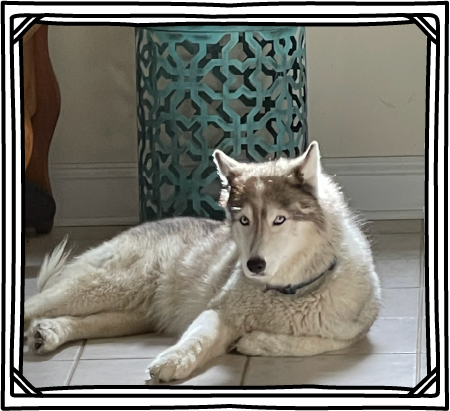The last thing we expected when we ran routine tests on our energetic husky, Sasha, were the words "She has cancer." Cancer has torn through my family-snatching my parents well before their time. It's what drove me into cancer research. Cancer haunted me once again when my husband was diagnosed with a rare tumor several years ago. Although I have a thorough understanding of the cancer world, canine cancer is very different from people cancer, and I was thrust into a whole new world. First, let's talk about that initial gut punch and hopelessness that comes along with a diagnosis. I was in a state of disbelief. As a patient advocate and researcher, I typically go into "take charge" mode with other people I work with. In this case, I initially couldn't think or speak. How could cancer strike again?!

After that initial shock, I was finally able to muster up a few questions about next steps and treatment options. In Sasha's case, the only option was surgery for the massive liver tumor. I did as much online research as I could but found so much conflicting information. It was so different from people cancer. I also had trouble finding credible and evidence-based information online. I made a list of 38 questions, prioritized them in order of urgency, and was relentless about getting the answers I needed to make an informed decision. And then the ethics of operating on a 13-year-old dog set in. Sasha is energetic and active, had no apparent symptoms and we stumbled upon her diagnosis during routine senior blood work and subsequent imaging. She seemed OK on the outside, but we didn’t know if she was uncomfortable on the inside since she wasn’t showing any changes or signs. Many of the posts I read online advised not to proceed with surgery on a senior dog. I lurked on online communities, where there were so many negative comments. I didn't publicize our decision since I needed to shut out the noise and just focus on the facts and evidence-based guidance. The surgeon gave us the assurance we needed, where the majority of the dogs he operated on for this particular condition were senior dogs and Sasha was in good health, otherwise. He broke every step down discussed all the benefits and risks, answered every question (even the dumb ones), and described what after-care would look like. I couldn’t just let this mass continue to grow, and I definitely wasn’t going to put her down. She still had so much life in her. And so, we decided to proceed with surgery...
The few days before surgery were surreal. We spoiled our girl with meals fit for a queen and daily trips to her happy place-the beach. She ran around like a two-year-old, swam in the frigid ocean (it was February!), and dug long tunnels in the sand. It was so hard to believe she was sick. The day of surgery was traumatic. She was a bit weary of going back to the animal hospital, and we did everything we could to assure her it would be OK. I planted myself in the waiting room for 5 hours-agonizing over “the what ifs”. I held back tears as I immersed myself in the stories of all the pets and their parents in the waiting room. Many of the pet parents had to make difficult decisions about their beloved pets, which were sometimes guided by financial impact since they didn’t have pet insurance. Some were looking into second mortgages, while others decided to opt out of further treatment. Distraught pet parents had to weigh the potential quality of life of their pet-today vs. after a potential intervention.

Five hours later, the surgeon assured us that Sasha did very well and was in recovery. Surgery was a little more complicated than he originally thought, given the side the mass was on. Sasha was monitored overnight, and we could pick her up later the next day. Reassured that everything would be OK, I went into caregiver mode-sterilizing the house, purchasing a variety of dog ramps to help transport her, inflatable collars in lieu of the dreaded plastic cone, dog beds to comfort her and a surgical shirt to help protect her incision. There’s so much research that goes into finding the right products and many didn’t work out. She wouldn’t be able to go up the stairs for a while, and I also bought a sleeping bag so I could sleep next to her. I worked from home for a few weeks and didn’t leave her side. I was so worried about a potential complication and was meticulous with discharge instructions. Every day she seemed a bit stronger, and on day 3 she was ready to play; although we did everything we could to limit her activity the initial days. During her post-op visit, Sasha got a clean bill of health, and we got the clearance to take her on longer walks. Four weeks later, we took her back to her happy place, where she ran around on the beach like a two-year-old again. She had an extraordinary amount of energy, and she seemed to be doing better than before her diagnosis. She also has a new habit that she acquired post-surgery, which is swiping the car window when she wants it open? She learned to swipe at 13! The fur on her belly hasn’t all grown back, where the fur oddly grew in to fully cover her incision, and she’s sporting a “belly mohawk”. But she’s healthy and that’s all that counts! Every situation is different, and I’ve learned so much from this experience. We would love to hear your stories.
The last thing we expected when we ran routine tests on our energetic husky, Sasha, were the words "She has cancer." Cancer has torn through my family-snatching my parents well before their time. It's what drove me into cancer research. Cancer haunted me once again when my husband was diagnosed with a rare tumor several years ago. Although I have a thorough understanding of the cancer world, canine cancer is very different from people cancer, and I was thrust into a whole new world. First, let's talk about that initial gut punch and hopelessness that comes along with a diagnosis. I was in a state of disbelief. As a patient advocate and researcher, I typically go into "take charge" mode with other people I work with. In this case, I initially couldn't think or speak. How could cancer strike again?!
After that initial shock, I was finally able to muster up a few questions about next steps and treatment options. In Sasha's case, the only option was surgery for the massive liver tumor. I did as much online research as I could but found so much conflicting information. It was so different from people cancer. I also had trouble finding credible and evidence-based information online. I made a list of 38 questions, prioritized them in order of urgency, and was relentless about getting the answers I needed to make an informed decision. And then the ethics of operating on a 13-year-old dog set in. Sasha is energetic and active, had no apparent symptoms and we stumbled upon her diagnosis during routine senior blood work and subsequent imaging. She seemed OK on the outside, but we didn’t know if she was uncomfortable on the inside since she wasn’t showing any changes or signs. Many of the posts I read online advised not to proceed with surgery on a senior dog. I lurked on online communities, where there were so many negative comments. I didn't publicize our decision since I needed to shut out the noise and just focus on the facts and evidence-based guidance. The surgeon gave us the assurance we needed, where the majority of the dogs he operated on for this particular condition were senior dogs and Sasha was in good health, otherwise. He broke every step down discussed all the benefits and risks, answered every question (even the dumb ones), and described what after-care would look like. I couldn’t just let this mass continue to grow, and I definitely wasn’t going to put her down. She still had so much life in her. And so, we decided to proceed with surgery...

The few days before surgery were surreal. We spoiled our girl with meals fit for a queen and daily trips to her happy place-the beach. She ran around like a two-year-old, swam in the frigid ocean (it was February!), and dug long tunnels in the sand. It was so hard to believe she was sick. The day of surgery was traumatic. She was a bit weary of going back to the animal hospital, and we did everything we could to assure her it would be OK. I planted myself in the waiting room for 5 hours-agonizing over “the what ifs”. I held back tears as I immersed myself in the stories of all the pets and their parents in the waiting room. Many of the pet parents had to make difficult decisions about their beloved pets, which were sometimes guided by financial impact since they didn’t have pet insurance. Some were looking into second mortgages, while others decided to opt out of further treatment. Distraught pet parents had to weigh the potential quality of life of their pet-today vs. after a potential intervention.

Five hours later, the surgeon assured us that Sasha did very well and was in recovery. Surgery was a little more complicated than he originally thought, given the side the mass was on. Sasha was monitored overnight, and we could pick her up later the next day. Reassured that everything would be OK, I went into caregiver mode-sterilizing the house, purchasing a variety of dog ramps to help transport her, inflatable collars in lieu of the dreaded plastic cone, dog beds to comfort her and a surgical shirt to help protect her incision. There’s so much research that goes into finding the right products and many didn’t work out. She wouldn’t be able to go up the stairs for a while, and I also bought a sleeping bag so I could sleep next to her. I worked from home for a few weeks and didn’t leave her side. I was so worried about a potential complication and was meticulous with discharge instructions. Every day she seemed a bit stronger, and on day 3 she was ready to play; although we did everything we could to limit her activity the initial days. During her post-op visit, Sasha got a clean bill of health, and we got the clearance to take her on longer walks. Four weeks later, we took her back to her happy place, where she ran around on the beach like a two-year-old again. She had an extraordinary amount of energy, and she seemed to be doing better than before her diagnosis. She also has a new habit that she acquired post-surgery, which is swiping the car window when she wants it open? She learned to swipe at 13! The fur on her belly hasn’t all grown back, where the fur oddly grew in to fully cover her incision, and she’s sporting a “belly mohawk”. But she’s healthy and that’s all that counts! Every situation is different, and I’ve learned so much from this experience. We would love to hear your stories.